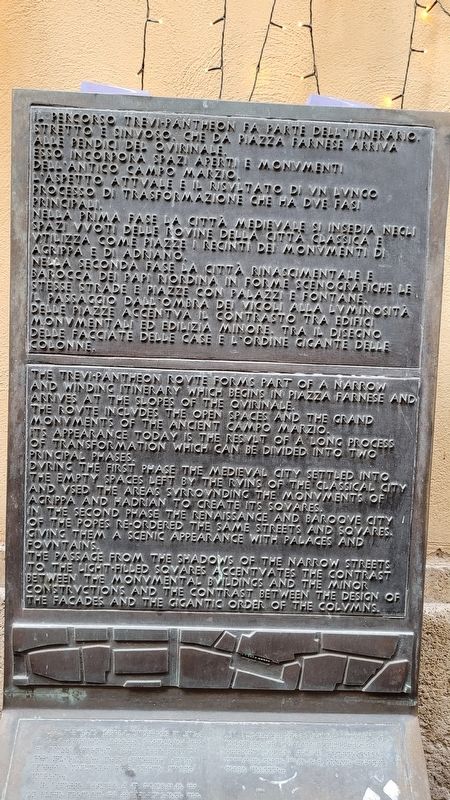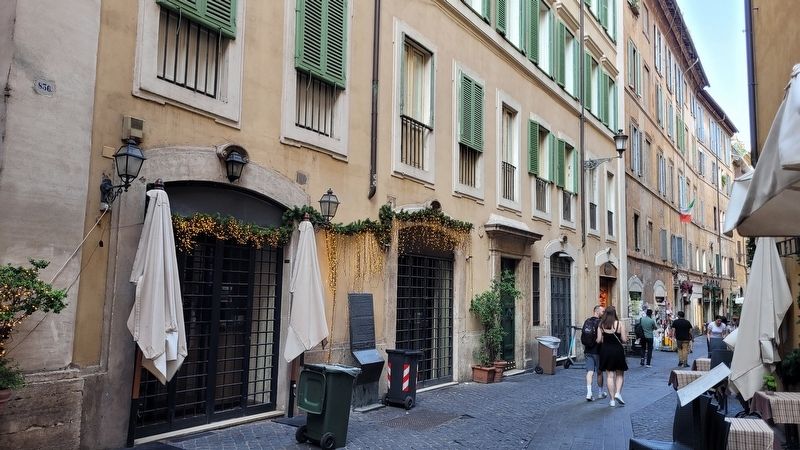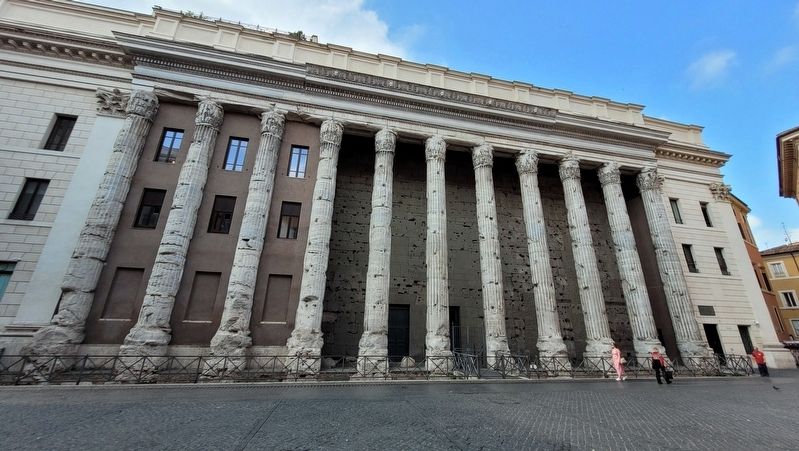Colonna in Roma in Città metropolitana di Roma Capitale, Latium, Rome, Italy — Central Italy (Tyrrhenian Coast)
Trevi-Pantheon Route
Nella prima fase la citta medievale si insedia negli spazi vvoti delle rovine della citta classica e vtilizza come piazze i recinti dei monvmenti di agrippa e di adriano. Nella seconda fase la citta rinascimentale e barocca dei papi riordina in forme scenografiche le stesse strade e piazze con palazzi e fontane.
Il passaggio dall'ombra dei vicoli alla lvminosita delle piazze accentva il contrasto tra edifici monvmentali ed edilizia minore. Tra il disegno delle facciate delle case e l'ordine gigante delle colonne.
The Trevi-Pantheon route forms part of a narrow and winding itinerary which begins in Piazza Farnese and arrives at the slopes of the Quirinale. The route includes the open spaces and the grand monuments of the ancient Campo Marzio. Its appearance today is the result of a long process of transformation which can be divided into two principal phases.
During the first phase the medieval city settled into the empty spaces left by the ruins of the classical city and used the areas surrounding the monuments of Agrippa and Hadrian to create its squares. The second phase the Renaissance and Baroque city of the popes re-ordered the same streets and squares. Giving them a scenic appearance with palaces and fountains.
The passage from the shadows of the narrow streets to the light-filled squares accentuates the contrast between the monumental buildings and the minor constructions and the contrast between the design of the facades and the gigantic order of the columns.
Topics. This historical marker is listed in these topic lists: Architecture • Roads & Vehicles.
Location. 41° 53.973′ N, 12° 28.704′ E. Marker is in Roma, Lazio (Latium, Rome), in Città metropolitana di Roma Capitale. It is in Colonna. Marker is at the intersection of Via dei Pastini and Via delle Paste, on the left when traveling west on Via dei Pastini. The marker is located at the corner of the building. Touch for map. Marker is at or near this postal address: Via dei Pastini, 112, Roma, Lazio 00186, Italy. Touch for directions.
Other nearby markers. At least 8 other markers are within walking distance of this marker. L'eclisse / The Eclipse (within shouting distance of this marker); Hotel Pantheon
(about 90 meters away, measured in a direct line); a different marker also named The Trevi-Pantheon Route (about 90 meters away); Rione III Colonna / Colonna District III (about 120 meters away); Hotel del Sole (about 120 meters away); Piazza della Rotonda (about 120 meters away); Albergo Cesari (about 150 meters away); Pantheon (about 150 meters away). Touch for a list and map of all markers in Roma.
More about this marker. The marker is one of several similar markers that highlights the specific route between the Trevi Fountain and the Pantheon.
Also see . . .
1. Pantheon, Rome. Wikipedia
The Pantheon (temple of all the gods) is a former Roman temple and, since 609 AD, a Catholic church (Basilicam Santa Maria ad Martyres or Basilica of St. Mary and the Martyrs) in Rome, Italy, on the site of an earlier temple commissioned by Marcus Agrippa during the reign of Augustus (27 BC – 14 AD). It was rebuilt by the emperor Hadrian and probably dedicated c. 126 AD. Its date of construction is uncertain, because Hadrian chose not to inscribe the new temple but rather to retain the inscription of Agrippa's older temple, which had burned down.(Submitted on July 24, 2023, by James Hulse of Medina, Texas.)
2. Trevi Fountain. Wikipedia
The Trevi Fountain (Italian: Fontana di Trevi) is an 18th-century fountain in the Trevi district in Rome, Italy, designed by Italian architect Nicola Salvi and completed by Giuseppe Pannini in 1762 and several others. Standing 26.3 metres (86 ft) high and 49.15 metres (161.3 ft) wide, it is the largest Baroque fountain in the city and one of the most famous fountains in the world.(Submitted on July 24, 2023, by James Hulse of Medina, Texas.)
3. Temple of Hadrian. Wikipedia
The Temple of Hadrian (Templum Divus Hadrianus, also Hadrianeum) is an ancient Roman structure on the Campus Martius in Rome, Italy, dedicated to the deified emperor Hadrian by his adoptive son and successor Antoninus Pius in 145 CE This temple was previously known as the Basilica of Neptune but has since been properly attributed as the Temple of Hadrian completed under Antoninus Pius. With one cella wall and eleven columns from the external colonnade surviving, the remains of the temple have been incorporated into a later building in the Piazza di Pietra (Piazza of Stone – derived from use of the temple's stones to build the piazza), whereby its facade, alongside the architrave which was reconstructed later on, was incorporated into a 17th-century papal palace by Carlo Fontana, now occupied by Rome's Chamber of commerce. While only part of the structure remains, excavations and scholarship have provided us with information regarding its construction techniques and stylistic influences, helping us recreate the building dynamics and significance of the Temple of Hadrian in Imperial Rome.(Submitted on July 24, 2023, by James Hulse of Medina, Texas.)
Credits. This page was last revised on July 24, 2023. It was originally submitted on July 23, 2023, by James Hulse of Medina, Texas. This page has been viewed 45 times since then and 6 times this year. Photos: 1, 2, 3. submitted on July 24, 2023, by James Hulse of Medina, Texas.


